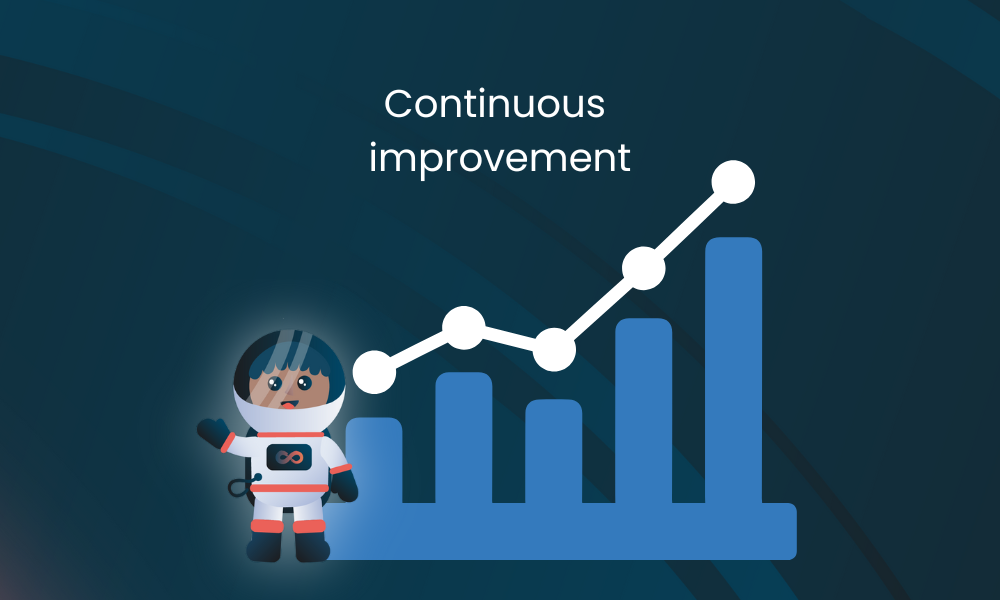Continuous improvement is an ongoing effort to improve something. Speaking about the website it's about building a repeatable, agile process for the team to continuously collect real user data, build high-impact items, and generate more momentum as users visit the website. Let's have a look at how to organize this process in the most effective way.

Why do you need continuous improvement?
If you're building a website using the Growth-Driven Design methodology (GDD), you're aware that there are three stages: website strategy, launch pad, and continuous improvement.
You've finished the strategy stage, and your launch pad website is now live. What comes next? You've now progressed to the next stage - continuous improvement. This stage focuses on enhancing the user value of your website and your company's growth month after month through specific activities that we'll outline below.
According to HubSpot's research, employing continuous improvement helped websites earn 14% more visits, 16.9% more leads, and 11.2% more revenue 6 months after launching. Doesn't that sound great?
Continuous improvement helps in achieving the greatest outcomes. It allows you to build your website using real data, enables your team to experiment with new ways to deliver value to visitors, opens up new commercial opportunities, and helps all departments meet their goals. It also increases your ability to adapt to a changing world and be proactive in your approach to change thanks to its flexibility and elaborate structure.
How to implement the continuous improvement stage?
At the core of continuous improvement lies lean thinking and an agile process. Let’s define these terms first.
Lean thinking is a framework for providing a new way of thinking about how to arrange human activities to bring greater advantages and value while reducing waste. It was coined by Daniel T. Jones and James P. Womack. Agile is an approach to project management that lets teams create value quicker by working in small, digestible increments.
How do we apply this to our processes? Well, at a high level, this stage consists of one large continuous improvement cycle, which happens over the course of a quarter. The cycle has two actions: planning and execution.
The planning is a process with the following activities:
- Refreshing the team on all the documents you created during the website strategy stage: SMART goals, Jobs-to-be-Done, personas, journey mapping, fundamental assumptions, website-specific strategy, and wishlist.
- Brief retrospective on the previous quarter.
- Open discussion around the overall strategy, direction, and focus of the team (challenges, ideas, pitches).
- Reviewing the team’s current theme from the website performance roadmap: establish, optimize, or expand.
The execution of the continuous improvement stage comprises a number of smaller cycles called sprint cycles.
Related article: How to develop a winning website strategy: 7 steps to success
What is a website performance roadmap?
The hardest job with continuous improvement is probably prioritizing. Your wishlist from the strategy stage definitely does not become shorter over time and continually grows. So how to help your team not to be snowed under? The GDD approach has a solution here: a website performance roadmap.
It’s a framework that will serve as a guide to building a high-performing website. It ensures that the team's time is spent on the items that will provide the most value to the user and help the company grow.
Let’s dive in.
Themes, focus areas, and tactics
There are three components to the website performance roadmap: themes, focus areas, and tactics. The first step is to come up with the theme's overarching direction. Then you must decide on the best path forward - the focus area. The final step is deciding on exact tactics.
As we previously mentioned, there are three main themes: establish, optimize, and expand. It's typical to stick with a theme for 6-9 months. Changing themes too frequently makes it difficult to find any major user learnings.
 (Image: Pexels)
(Image: Pexels)
Each theme has its own set of three focus areas. In addition, each focus area has a metric that is linked to progress in that area, so-called, the focus metric. To have an influence on this metric, your team will need to use a variety of particular activities. Each activity or tactic may have its own set of metrics to track to see how well it's working.
Pro tip: To avoid losing attention, try to choose only one focus area every cycle.
To make it easier for you to see and consume, we've broken down each theme into its relevant focus areas with its goal, metrics, and tactics.
1. "Establish" theme
The “establish” theme is often realized immediately after launching and is centered around the fundamental tasks you need to undertake after you've established something new. First, finish any essential elements that didn't make the original launch cut. Second, get everyone involved so that your team can begin gathering data. Last but not least, examine if the visitors are engaged and interested in what you've created.
The three focus areas of the “establish” theme are "harvest," "audience," and "value":
| Focus area | Goal | Metric | Tactic |
| Harvest | Create high-impact features that are simple or quick to implement immediately after launch. | The team's capacity to improve velocity along each sprint cycle. | 1. Building high-impact nice-to-have components 2. Analyzing the first user data, the technical implementation, and performance 3. Improving internal processes and removing roadblocks |
| Audience | Create a steady flow of good-fit visitors in order to collect data and feedback. | Month-over-month unique visitor growth. | 1. Working on SEO 2. Building topic clusters 3. Building search-friendly digital products 4. Paid advertising |
| Value | Ensure that all primary website features assist users in resolving their problems and providing value. | Net Promoter Score (NPS) - associated with each major element on the site. | 1. Using NPS follow-up questions to learn about areas for improvement from customers 2. Obtaining feedback from your ambassadors 3. Conducting neutral and detractor user interviews 4. Identify gaps in content and work on its depth to provide answers for your viewers 5. Setting up an on-page chat |
So that's the "establish" theme, complete with its three focus areas, metrics, and possible tactics to contemplate. It will definitely prove to be your best asset if you have recently launched your website.
2. "Optimize" theme
The "optimize" theme focuses on enhancing the user experience as well as the website's performance. It’s divided into three sections: "usability," "conversion rate optimization (CRO)" and "personalization”:
| Focus area | Goal | Metric | Tactic |
| Usability | Assist visitors in solving issues, answering questions, and unlocking value as quickly as possible, making sure the website is intuitive, engaging, and simple to use. | Depends on the user's distinct goal for every web page or section. | 1. Creating user interfaces that are familiar to the user 2. Conducting user testing for important actions 3. Reducing distractions and perplexing elements |
| CRO | Reduce the number of steps between a user entering the funnel and completing the end-of-funnel conversion event by eliminating friction points. | Conversion rate through the funnel. | 1. Segmenting users 2. Reducing the number of steps required for a user to reach the conversion goal 3. Putting big ideas to the test |
| Personalization | Ensure that all primary website features assist users in resolving their problems and providing value. | Based on the previous metrics. |
1. Segmenting all the previous metrics by your primary persona |
This theme is an excellent place to start if you want to make sure your website is performing at its best.
3. "Expand" theme
The "expand" theme is excellent to create new valuable things and use the website to help your company grow. Its three focus areas include "product", "journey", and "teams":
| Focus area | Goal | Metric | Tactic |
| Product | Launch new digital web products valuable for users with free access. | Depends on the goal of your digital web product. | 1. Using a mini-strategy approach, which includes workshops, to focus on that specific stage of the journey. 2. Auditing all of your existing content to construct a web product around it. |
| Journey | Find new methods to utilize the website to drive user value and company goals in new stages along the journey. | Depends on which stage of the customer journey you’re focusing on. | 1. Creating a special area on the website for new customers 2. Creating and growing an advocacy program based on the website |
| Teams | Find innovative methods to leverage the website to assist other teams around the business in scaling and achieving their objectives. | Based on the specific department you’re working with. |
1. Collaboration with each department to develop various tools and sections that can help them. |
So that's it!
Remember, that every website, team, company, and industry is different and might require different focus areas and metrics. Let the roadmap you’ve learned about serve as your starting point upon which you can build from. However, this is you who decides how to flow through the roadmap. It can be modified to best fit your unique situation, but most important here is to have your data, user feedback, and business goals as a guide.
We mentioned a lot about sprint cycles, so what’s this to work in sprints? Let’s cover this now.
How to work in sprint cycles
Did you know that working in sprints can help drastically? By working together in multi-week sprints, teams are able to achieve more than 80% cycle time improvements.
The sprint cycle you’ll follow for continuous improvement has four steps: plan, build, learn, and transfer.
 (Image: Pexels)
(Image: Pexels)
The plan step
The plan step is the most important of them all. Its purpose is to ensure that you're making the most effective items possible in order to move closer to your focus metrics.
This step is divided into various sections:
- Examine your present theme, goals, and focus.
- Write job stories - a brief description of your user, the job they want to accomplish, and the desired outcome.
- Hold a planning session with the entire team and, if feasible, stakeholders to decide the highest impact items to build during this sprint in order to complete your job stories and advance toward your business goals. You'll have wishlists at the end of these workshops.
- Create a card for each wishlist item based on its importance.
This step will ensure that your team is coming up with innovative ideas and putting them into action.
If you need a help with a planning session, get in touch with us.
The build step
The goal of the build step is to launch a collaborative effort on executing the high-impact action items as quickly as possible. The main activities here are:
- Break down each action item into individual pieces which must be accomplished.
- Arrange everyone's schedule so that they have the same days and hours marked out on their calendars before the sprint start.
- Organize team daily standups.
- Outline and run experiments and quality assurance (QA).
Pro tip: to run stand-ups efficiently, make them consistent, focused, and short. Try to have them at the same time, place, and no longer than 15 minutes. Let everyone explain the done work, plans, and roadblocks in one minute, and don’t forget to use project management tools like ClickUp or Jira.
The learn step
The goal of the learn step is to deepen your understanding of both users and the team so you can make smarter decisions in your future cycles to drive more value.
In the beginning, pull the team for a retrospective meeting where you can reflect on the action items, user's behaviour, and the team’s performance. Once you’ve had your discussion, finalize your learnings and create team kaizen (which means "change for the better" or "continuous improvement" in Japanese).
The transfer step
The goal of the transfer step is to share learnings across departments and find opportunities to align to create a better user experience throughout the entire customer journey.
There are two primary ways to achieve this goal. First, host an ongoing “learning, alignment, and collaboration” (ACL) meeting. Second, develop a company-wide internal documentation system.
The purpose of the ACL meeting is to meet with other departments on a regular basis to assist in achieving their goals. This meeting should be held at the end of each sprint cycle or the end of each month.
The second element in this step is to document the team’s goals, completed action items, experiments, and learnings in a transparent and open manner. Consider using an internal knowledge base that can be shared and commented on company-wide. If the previous steps were properly implemented and documented, the majority of the documentation is basically done. Gathered information wraps up all four steps of the sprint cycle.
Let's take a look at the whole stage of continuous improvement. In the quarter, totally your team will complete six bi-weekly sprint cycles. And at the end of the sixth sprint cycle is time to return to the quarterly summit to review progress and make any necessary changes for the following quarter.
The purpose of all of this is to use an agile approach to establish a cadence with the team. This rhythm gains traction over time and you'll notice better outcomes every month, uncovering new opportunities that are unattainable through the traditional web design approach.
Ready for the Growth-Driven Design? Contact us